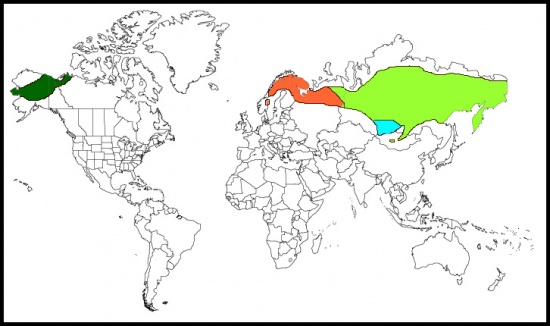Alternative name: Siberian Tit; Taiga Chickadee; Alaskan Tit
- Poecile cinctus
Identification
13.5 - 14cm (5¼-5½ in). A medium sized tit .
- Large, dark brown head
- White cheeks
- Brown mantle
- Black wing feathers with pale fringes
- White underparts
- Pale brown flanks
Colours variable, birds from southern Siberia browner, birds from Taymyr Peninsula greyer. Sexes similar.
Similar species
May be confused with Boreal Chickadee in Alaska and Canada, but Siberian Tit is larger, has a whiter neck side, paler brownish-buff flanks and broader whitish edges on tertials.
Distribution
| Scandinavia and northern Asia, Alaska and the far northwest of Canada. | |
| Legend • P. c. lathami; year-round |
Taxonomy
Formerly placed in genus Parus as Parus cinctus; for a while the specific name of cincta was commonly used, but the world wide checklists are now using Poecile cinctus.
Subspecies
This is a polytypic species[3] consisting of 4 subspecies:
- P. c. lathami in Alaska and northwest Canada
- P. c. lapponicus in Fennoscandia (Norway, Sweden, Finland) and northern european Russia
- P. c. cinctus from northeast Russia over Siberia to Kamchatka
- P. c. sayanus in southern Siberia and northwest Mongolia
Habitat
Conifer forests, mostly of old-growth spruce, especially in areas with dead trees.
Behaviour
Diet
Feeds on small invertebrates like bugs, moths, flies and others. Takes also seeds. Stores food in variety of caches and visits these caches in winter.
Breeding
Breeding season from May to July. Pairs for life. The nest is placed in a hole (often old woodpecker holes) and made with wood, moss, animal hair and grass stems. Lays 4 to 11 eggs.
Movements
Adults are resident, young birds may wander around, flocking with Willow Tit.
References
- Del Hoyo, J, A Elliott, and D Christie, eds. 2007. Handbook of the Birds of the World. Volume 12: Picathartes to Tits and Chickadees. Barcelona: Lynx Edicions. ISBN 978-8496553422
- Harrap, S and Qinn D. 1996. Tits, Nuthatches and Treecreepers. Christopher Helm, London. ISBN 0713639644.
- Clements, J. F., T. S. Schulenberg, M. J. Iliff, T. A. Fredericks, J. A. Gerbracht, D. Lepage, S. M. Billerman, B. L. Sullivan, and C. L. Wood. 2022. The eBird/Clements checklist of Birds of the World: v2022. Downloaded from https://www.birds.cornell.edu/clementschecklist/download/
Recommended Citation
- BirdForum Opus contributors. (2024) Grey-headed Chickadee. In: BirdForum, the forum for wild birds and birding. Retrieved 28 April 2024 from https://www.birdforum.net/opus/Grey-headed_Chickadee
External Links
GSearch checked for 2020 platform.





